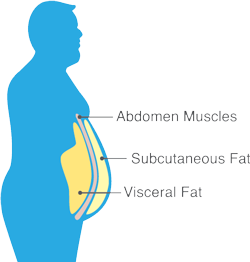Visceral Fat Calculator
What is Visceral Fat?
Visceral fat is the intra-abdominal adipose tissue stored around several organs, including the stomach, the intestines and the liver. An increase in visceral fat of more than 130 cm² defines Visceral Obesity, a major risk factor of several chronic diseases at any weight or BMI level 1,2. Visceral fat depots might increase in people having normal weight, overweight or obesity.

What causes Visceral Obesity?
Obesity, including Visceral Obesity, is a chronic multifactorial disease, possibly due to a combination of several factors such genetic predisposition, obesogenic environments, chronic positive energy balance, sedentary lifestyles, hormonal dysregulations, psychological issues and/or gene-environment interactions3,4. Your physician can help you to diagnose and treat the cause of your disease.
Health issues associated with Visceral Obesity
Visceral Obesity is a major risk factor for developing several metabolic (type 2 diabetes), cardiovascular (hypertension, heart attack), inflammatory (Crohn’s disease, ankylosing spondylitis) and oncological (colon cancer) diseases, as well as dementia and early death, independently of the total fat mass6-14.
The Visceral Fat Calculator is based on an anthropometric model combining a limited number of measurements2, and was validated as the most accurate predictor of cardiometabolic risk, as well as cardiovascular, cancer and all-cause mortality, when biomedical imaging data are not available10,11,15.
Visceral Obesity management
Aerobic exercise (brisk walking, cycling, swimming or running) for at least 30 minutes, 5 to 7 days per week, helps to reduce visceral fat. The full 30 minutes aerobic exercise might be done at 1 time or split, for example, into 3 times of 10 minutes.
A High-Intensity Interval Training (HIIT) might be considered under the supervision of a physiotherapist or a sport coach, after a cardiac risk assessment, to ensure the absence of any cardiovascular event. HIIT includes short periods of intense exercise (fast pedalling, sprint workout and squat jump) alternated with recovery periods5.
Your physician might suggest other treatments.
General Obesity
Usual measurement of obesity, validated by the World Health Organisation, is based on the BMI assessment. General obesity, or total fat mass depot, is usually defined by a BMI ≥ 30 kg/m2; compared to overweight (25 ≤ BMI < 30 kg/m2) and normal weight (18.5 ≤ BMI < 25 kg/m2)16. Specific cut-offs are defined in the Asian populations for overweight (23 ≤ BMI < 27.5 kg/m2) and obesity (BMI ≥ 27.5 kg/m2)17.
However, BMI does not distinguish between fat mass and fat free mass and therefore constitutes a poor diagnosis tool of general obesity18-20.
BMI gives only a general idea on the corpulence. In addition, the BMI does not give any indication on Visceral Fat, major risk factor of several chronic diseases independently of the total fat mass.
Contact

• Dr Hanen Samouda, PhD (LIH), Researcher
• Dr Frédéric Dadoun, MD, PhD (CHL), Medical doctor & Researcher
How to cite
Samouda H, Dutour A, Chaumoitre K, Panuel M, Dutour O, Dadoun F. VAT=TAAT-SAAT: innovative anthropometric model to predict visceral adipose tissue without resort to CT-Scan or DXA. Obesity (Silver Spring). 2013;21(1):E41-50.
References
1. Hunter GR et al. Obes Res. 1994; 2(6):563-568.
2. Samouda H et al. Obesity 2013; 21: E41-E50.
3. Bray GA et al. Obes Rev. 2017; 18(7):715-723.
4. Sharma AM et al. 2018; 35(3): 285-292.
5. EASO. 2021; Recommendations of the EASO Physical Activity Working Group.
6. Van Gaal LF et al. Nature. 2006; 444(7121): 875-880.
7. Cereda E et al. Age Ageing. 2007; 36(5): 488-491.
8. Fontes-Carvalho R et al. Am J Cardiol. 2014; 114(11): 1663-1669.
9. Yu H et al. Surg Obes Relat Dis. 2015; 11(1): 6-11.
10. Brown JC et al. Am J Hum Biol. 2017; 29(1).
11. Brown JC et al. Eur J Nutr. 2018; 57(1): 191-198.
12. Dan Lantsman C et al. Clin Radiol. 2018; 73(10): 910.
13. Kuritzkes BA, et al. Int J Colorectal Dis. 2018; 33(8): 1019-1028.
14. Magro DO, et al. Arq Gastroenterol. 2018; 55(2): 142-147.
15. Ruiz-Castell M et al. Sci Rep. 2021; 11(1): 9121.
16. WHO. 2000; Obesity: preventing and managing the global epidemic. Report of a WHO Consultation.
17. WHO. 2000; The Asia pacific perspective: Redefinig obesity and its treatment.
18. Garn SM et al. Am J Clin Nutr. 1986; 44(6): 996-997.
19. Frankenfield DC et al. Nutrition. 2001;17(1):26-30.
20. Adab P et al. BMJ. 2018; 360:k1274.
